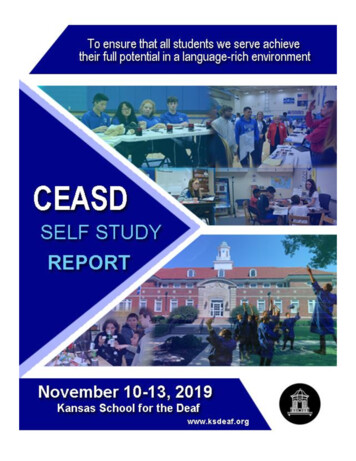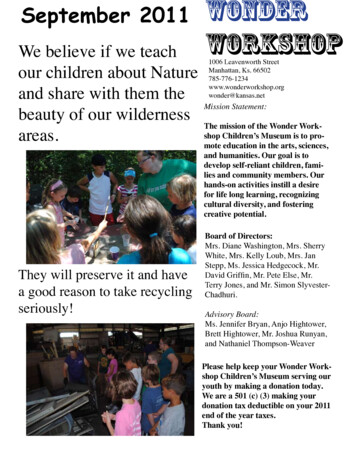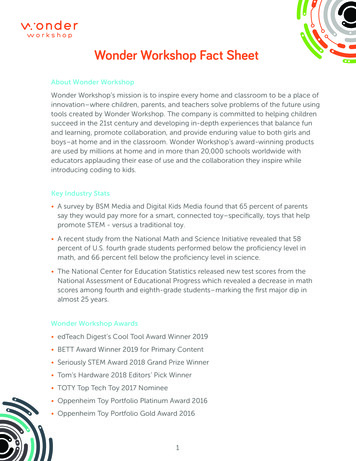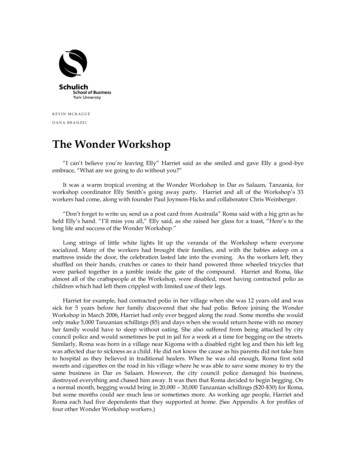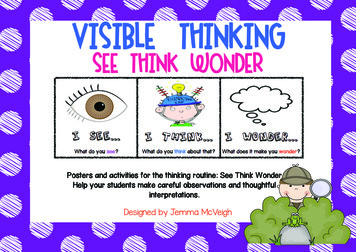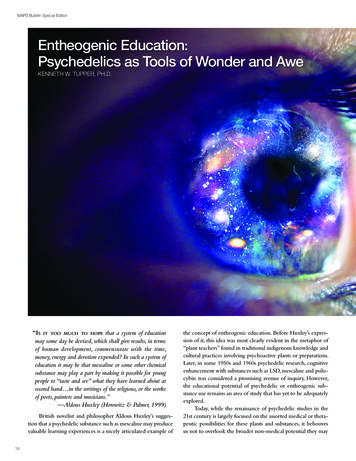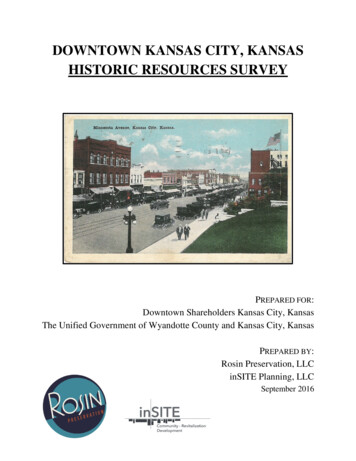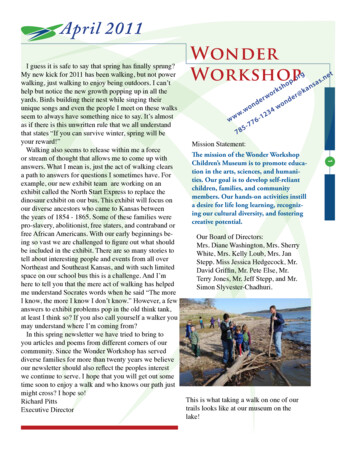
Transcription
April 2011www.w785-don7er76rwo123kso4wnrde@kaMission Statement:The mission of the Wonder WorkshopChildren’s Museum is to promote education in the arts, sciences, and humanities. Our goal is to develop self-reliantchildren, families, and communitymembers. Our hands-on activities instilla desire for life long learning, recognizing our cultural diversity, and fosteringcreative potential.Our Board of Directors:Mrs. Diane Washington, Mrs. SherryWhite, Mrs. Kelly Loub, Mrs. JanStepp. Miss Jessica Hedgecock, Mr.David Griffin, Mr. Pete Else, Mr.Terry Jones, Mr. Jeff Stepp, and Mr.Simon Slyvester-Chadhuri.This is what taking a walk on one of ourtrails looks like at our museum on thelake! I guess it is safe to say that spring has finally sprung?My new kick for 2011 has been walking, but not powerwalking, just walking to enjoy being outdoors. I can’thelp but notice the new growth popping up in all theyards. Birds building their nest while singing theirunique songs and even the people I meet on these walksseem to always have something nice to say. It’s almostas if there is this unwritten rule that we all understandthat states “If you can survive winter, spring will beyour reward!”Walking also seems to release within me a forceor stream of thought that allows me to come up withanswers. What I mean is, just the act of walking clearsa path to answers for questions I sometimes have. Forexample, our new exhibit team are working on anexhibit called the North Start Express to replace thedinosaur exhibit on our bus. This exhibit will focus onour diverse ancestors who came to Kansas betweenthe years of 1854 - 1865. Some of these families werepro-slavery, abolitionist, free staters, and contraband orfree African Americans. With our early beginnings being so vast we are challenged to figure out what shouldbe included in the exhibit. There are so many stories totell about interesting people and events from all overNortheast and Southeast Kansas, and with such limitedspace on our school bus this is a challenge. And I’mhere to tell you that the mere act of walking has helpedme understand Socrates words when he said “The moreI know, the more I know I don’t know.” However, a fewanswers to exhibit problems pop in the old think tank,at least I think so? If you also call yourself a walker youmay understand where I’m coming from?In this spring newsletter we have tried to bring toyou articles and poems from different corners of ourcommunity. Since the Wonder Workshop has serveddiverse families for more than twenty years we believeour newsletter should also reflect the peoples interestwe continue to serve. I hope that you will get out sometime soon to enjoy a walk and who knows our path justmight cross? I hope so!Richard PittsExecutive DirectorWondertrgneWorkshopo.spahons
Dan Mulhern, atUS Fish and Wildlife ServiceIn October 2005 the U.S. Fish and Wildlife Service began working with a group of private ranchersin Logan County, Kansas who offered their property as a reintroduction site for the endangered blackfooted ferret. The ferret depends on large tracts of prairie dogs for its survival; feeding almost exclusively on prairie dogs and living in their burrows. A first release of 24 captive-bred animals was madeon December 18, 2007. Through a combination of subsequent releases and reproduction of animalson-site, the population has continued to expand at a steady rate. Documentation of second- and thirdgeneration wild-born kits indicates the initial success this effort has shown. The overall populationwas estimated to be approximately 100 animals heading into the winter of 2010-2011. Some wintermortality is to be expected, and surveys conducted this spring should give a good indication of thehealth of the breeding population prior to the next reproductive season.
Questions from Wonder Workshop after school Kids:Mr. Mulhern, but what does this mean to the ecosystem of Logan CountyKids, preservation of prairie dog colonies can do more for rangeland biodiversity than justabout anything else that can happen; so many more species occur within and ecological processes are so much more complex in a prairie dog colony than in similar shortgrass prairiewithout prairie dogsMr. Mulhern are the ranchers committed for how many years,Mr. Mulhern what caused the ferrets demise,Loss of habitat (prairie dogs) through intentional eradication, conversion of prairie to non-prairie uses, and an exotic disease (sylvatic plague) led to the near-extinction of the black-footedferret.Mr. Mulhern what is the expected life span of the ferrets,They can live 6 years or more in captivity, very few reach their 4th birthday in the wildMr. Mulhern who implemented and watches over the project and how did the US Fish andWildlife Service get involved?Students the USFWS is the primary proponent of this project, although we have lots of partnersfrom governmental and non-governmental entities; the ranchers first approached us (throughAudubon of Kansas) inquiring about our interest in putting ferrets on their landThank you Mr. Dan Mulhern!Dan MulhernUS Fish and Wildlife ServiceManhattan, KS785-539-3474, ext 109 The ranchers we are working with all appear to be committed for however long it takes to establish self-sustaining ferret populations
Short StoriesBy Homer Wells!I was looking these over one nightwhen I was up to pages in the fifties and noticed that probably a third of these are aboutthe body. To me they are funny. If they annoy you I apologize. Retta my wife, alwayssaid that if the Wells’ didn’t talk about theirbodies they wouldn’t have anything to talkabout. After looking at these stories who’sgoing to argue with her?PapawsI was always playing in the timber. There was asmall stream right close to the house and lots ofwoods. When you see the ads about how greenthe oil companies are you can take that witha grain of salt. They are green when they areforced to be green, otherwise they do whatevernecessary to get the most in their pockets withthe least expense. They drilled a well right nextto that little stream, and instead of building aslush pond for the slushy old mud that came outof the well, they just dumped it in the stream.Billy Manners and I were playing war downthere one day long after they finished the well.We noticed some trees with fruit on them thatwas oblong and round, you know kind of like ahand grenade. Those things made a big splashin the slush left by the drilling rig. We foughtGermans until we ran out of hand grenades.About a week later I was with my dad Homerwhen we came across a man from town. Heasked dad if he knew anything about the papaws that season. Dad told him he hadn’t paidany attention, as he didn’t eat them. The mansaid that he couldn’t understand it he had beenout about 3 weeks ago and they were thick andnow there weren’t any.After the man left scratching his head, I toldHomer what Billy and I had done. Homer said,“That’s alright, those things aren’t fit to eat anyway.” You know to this day I have never tasteda papaw. When I would start to tell something that happenedto my family or me, my son-in-law would alwayscomplain that he didn’t have his tape recorder. Hewould say that he wanted to tape some of thosestories for his kids and grand kids. Then one daymy daughter gave me a book that some womanfrom southeast Kansas wrote about the storiesher dad and his brothers would tell when they gottogether. I was raised in east central Kansas andher stories were about the 30’s and 40’s so I couldrelate to every one of them. While editing video formy son Mike’s ministry one evening it came timeto compress them. This always takes a long time;anywhere from a couple hours to all night. WhileI was waiting I decided to write some of these talltales down. One led to another and now I think Iwill never finish at least I hope not.When I started I was going to use factitious names, but what do you use for Kider Camp,Country Loose or Skeeter Potts? I think that mostof the people I have written about are dead by nowso I have used real names of real people. If I haveoffended anyone I’m truly sorry.Now I hope you realize that I’m gettinga little long in the tooth, and sometimes I can’tremember when I’ve told a story. So if you findsome of these stories more than once I just hopethey are the same. You can tell the stories from thelies, because the lies won’t be the same twice. Thatdoesn’t mean that the ones that are the same arenecessarily true; they could be or I could have justgotten lucky.
Poems from the neighborhood!GeodesBy Elora RootSomething for CertainDrums played onWith the primordial bassEchoing in the background.The beat was different for some --the SeersElaborate dances evolvedEmanating from the percussionReverbating into spiraling armsof resonant beauty.And there was truth and lightAmongst the music and the masses.Momentum spread in wavesGrowing and touching others --infinitely expandingUntil they collapsed on themselves.The void was filled without formBut only a brilliant, blinding illuminationAnd we knew something for certain.By Jeff NealPeople get readyFor the Underground Railroadis bound for Freedomall you needis the desire to be free.The train runsthrough dangerSeen and unseenbut it gets there.The Underground Railroadtakes you to placesthat a regulartrain can’t go.It’s Conductoris someonewho believes in Freedomand Justice.Come oneCome allTo the Freedom TraintheUndergroundRailroadBy James Edgar Spencer III A deep, sparkling holewith quartz all aroundincased in a dull-looking rockopen it and seeotherworldly wondersinside an ordinary rockthings are not alwayswhat they seemso look carefullybefore you assumethat the rockis ordinaryThe Underground Railroad
By Hillary Trelease When I began drinking tea around the age of 8 or 9, I was content with tea bags, which I reusedfrequently and reheated in the microwave. 20 years later my relationship with tea has grown anddeveloped to the point where tea is not just a beverage to me but a comforting friend, a way ofcommunication, and an integral part of my health and fitness. Tea calms me down, and wakes meup. It is new and exciting and Old Faithful. In short, tea is a good friend.After water, more people in the world drink tea than any other beverage. It transcends boundariesof age, social class, and culture. In broad terms tea (which I will use to include true tea from theplant Camellia sinensis and herbal tisanes) is incredibly diverse. Fruity, flowery, earthy, citrus-y,spicy, black, green, or white, there is a tea for your taste, each boasting a host of health benefits.But perhaps my favorite aspect of tea is in the preparation, the contemplative ritual, the dance ofthe tea leaves.Whether you use tea bags or loose tea, the first key aspect is water. Always begin with fresh, coolwater. Any drinkable water is fine whether it comes from a tap or a filter, but keep in mind thatsoft water can cause a flat, flavorless tea, and while healthful minerals naturally found in watercan add body and richness to your tea, additives such as chlorine can affect the both the flavor andaroma (which is inextricably linked to our appreciation of flavor). I advocate using a tea kettle forheating water, but if you do microwave it, be sure to get it hot enough. To boil water for black teatakes about 3-5 minutes depending on how ambitious your microwave is. If you are brewing greentea merely steaming water will do nicely. Next, pour the water over the tea rather then droppingthe tea bag into a cup of water. This action aerates the water allowing more oxygen bubbles to gettrapped within increasing the flavor of your tea.The Dance of the Tea Leaves: If you are using tea bags, which are essentially filled with the broken bits and dust from the sifted tea leaves, watch for the bag to inflate. This is a good indicationthat your water is hot enough to brew the tea well. If you are brewing loose tea, the more roomit has, the better. A tea ball is OK. A tea pot with an infuser is better, and I really love to use afrench press. Not only does it allow the leaves plenty of room, the clear glass lets you enjoy thedelicate ballet happening inside. As the tea steeps, the leaves gently unfurl and begin to bob andtwirl gracefully through the water.The general rule for tea is 2-3 minutes for green tea, 3-5 minutes for black tea and 5-10 minutesfor herbal teas, but I am hesitant to say this is a hard and fast rule. Some teas can get sharp in lesstime while some can develop rich body with a longer, undisturbed steep. Experiment, and don’tgive up.One of the most helpful bits of wisdom I have gleaned over the years is the decaffeinating tip.This works especially well with a good loose black tea that has plenty of flavor. Simply cover theleaves with a small amount of boiling water, let it sit for 30 seconds then pour off that water andfill with fresh. 80% of the caffeine in tea moves from the leaves into the water in the first 30 seconds of brewing.So whatever your preference for plain, flavoured, black, green or herbal, treasure the moments ittakes to brew your tea. Whether you are alone or with friends, infuse yourself with the good healthof tea drinking and enjoy the dance of the tea leaves.
By Melissa NewmanThis past summer I had the wonderful opportunity to spend two months with orphans in Jacunda Brazil. I was presented with this opportunity last fall through the school of Leadership Studies at K-statein coordination with Project Rescue for Amazon Youth (P.R.A.Y) an organization out of Wamego,Kansas. We spent a semester learning culture, planning for every possibility, learning Portuguese,creating projects for the kids, and bonding with team members. After 6 months of planning, we wereready to go! What a great trip and a life changing experience it was! Working with the Wonder Workshop kids really helped when deciding what types of activities to do with the Brazilian kids, for example, we talked about American culture with the kids at Wonder Workshop and they made a culture quiltand wrote cards to give to the Brazilian kids. When we were in Brazil we did the same project withthem talking about Brazilian culture, and brought it back to the United States, all the children were sofascinated and amazed that what they had in their hands was created by children just like them fromanother country. One of the challenges I faced on this trip was the lack of respect from the kids and thefeeling that they did not appreciate what we were doing there. I don’t know why I thought these kidswould be prefect; I was wrong, clearly. Kids will be kids whether they are in America or Brazil; afterawhile I came to this realization and it made the trip so much more enjoyable. The great thing aboutkids is that they are easy to bounce back, so if they get mad at you or don’t like some activity you wantto do with them, it only takes about 5 minutes for them to love you again. It is amazing how kids candig their little hands into your heart and have such a great influence on you and who you become. Iloved my experience in Brazil and hope to visit again soon.
They Have VoicesByBennett OrtonHand drums have a voice. That was the first piece of information that opened up my eyesto hand drums and drum circles. My first involvement to hand drumming was at a health/worshipcenter in Topeka, Kansas. My instructor was Joan; Joan was very talented and also obtained wisdomconcerning rhythm of music. Joan said each drum has a voice. Certain drums will speak loudly toothers or not at all. Once I picked up a stranger’s drum (asking first of course) I was amazed by therhythms that were created. I was unaware that I could make such sounds. Only to learn through timethat it was that certain drum that allowed me to have a conversation with that drum.I often enjoy exploring nature with my drum. I’ll take my drum to a park, the lake shore, oran open meadow and play with nature. I like to see how the animals, insects and cloud patterns interact with my song. These are my most favorite and memorable moments drumming. The old onessay “The beat of the drum is Mother Earth’s heart beat.” By drumming solo or with others bringsmyself the opportunity to create music, Earth’s universal language. Joan also said that one must never say that they will beat the drum. Beating a drum is a negative action, one should play the drum with positive emotions. By playing the drum one is starting aconversation and also a conversation with their soul/spirit within. When I pick up my drum and starta simple rhythm I will find myself strolling into my imagination’s hallway amongst the clouds. Thisis where bliss is found.
Greetings Families,Plan a mini vacation close to homeand stay at the Wonder WorkshopMuseum/Camp for a night, weekend,or week and bring the kids or enjoythe pristine wilderness area withyour spouse! E-mail Richard Pitts at wonder@kansas.net, for a price quote, and tellus when you would like to be ourguest?
Pictures from the Underground Railroad Tour on February 26,2011. On the day of the tour we had 40 people show up in the coldand snow, it was awesome! These pictures were taken by BrettHightower.10
Wonder Workshop. 2 In October 2005 the U.S. Fish and Wildlife Service began working with a group of private ranchers in Logan County, Kansas who offered their property as a reintroduction site for the endangered black-footed ferret. The ferret depends on large tracts of prairie dogs for its survival; feeding almost exclu-

